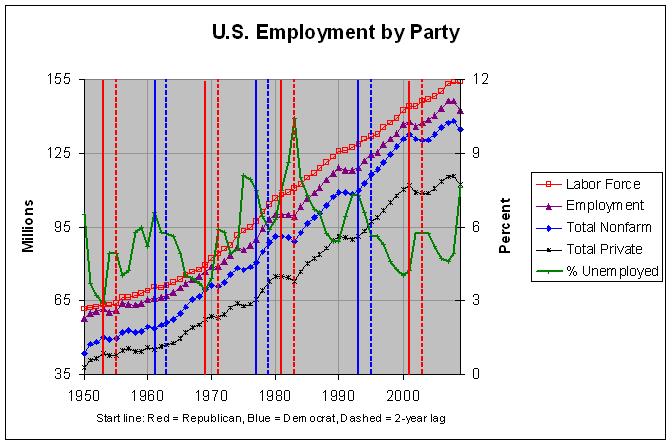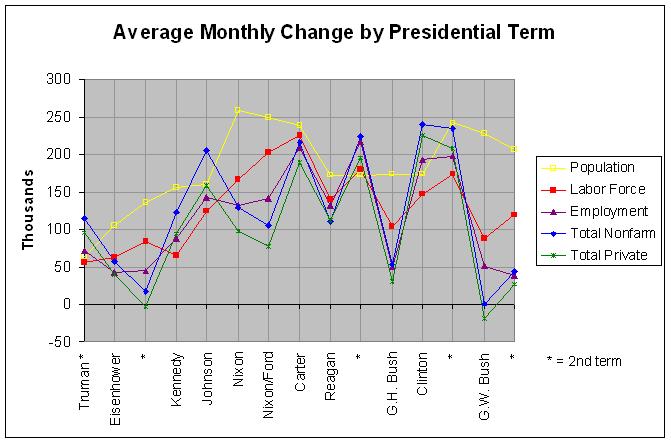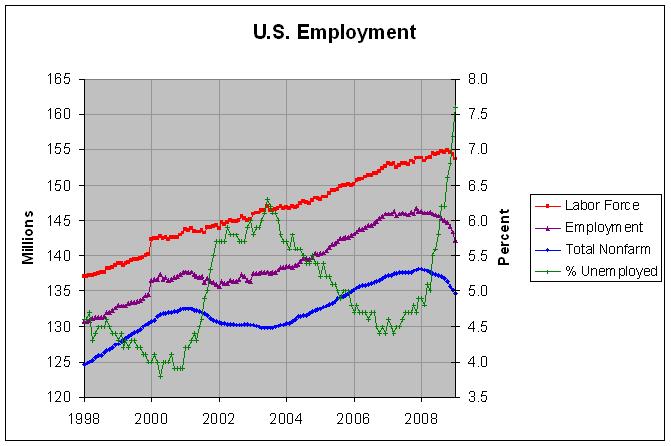NONFARM AND HOUSEHOLD SURVEY EMPLOYMENT GROWTH BY PRESIDENTIAL PARTY (percent annualized)
Nonfarm Employment Growth Household Survey Employment Growth
----------------------------------- -----------------------------------
1-Year 2-Year 2-Year 1-Year 2-Year 2-Year
President Mo Year No Lag Lag Lag^ Skip^ No Lag Lag Lag Skip Party
----------- --- ---- -------- -------- -------- -------- -------- -------- -------- -------- -----
Roosevelt Jan 1941 3.2 2.1 1.3 1.7
Truman Jan 1945
" Jan 1949 1.4 1.0 0.5 1.6 Dem
Eisenhower Jan 1953 0.9 1.3 1.6 1.4 0.8 1.2 1.2 1.3 Rep
" Jan 1957
Kennedy Jan 1961 3.3 3.3 3.0 3.6 2.0 2.2 2.0 2.3 Dem
Johnson Jan 1965
Nixon Jan 1969 1.9 2.2 2.9 2.2 2.0 2.3 2.7 2.2 Rep
Nixon/Ford Jan 1973
Carter Jan 1977 3.1 1.7 0.0 1.2 2.7 1.4 0.3 1.0 Dem
Reagan Jan 1981 1.6 1.8 2.3 2.1 1.5 1.7 1.9 1.8 Rep
" Jan 1985
G.H. Bush Jan 1989
Clinton Jan 1993 2.4 1.9 1.4 2.2 1.8 1.3 1.2 1.7 Dem
" Jan 1997
G.W. Bush Jan 2001 0.5 0.8 1.0 1.0 0.7 1.1 1.0 1.0 Rep
" Jan 2005
Aug 2008
All Democrats 3.0 2.3 1.6 2.3 2.0 1.6 1.2 1.8
All Republicans 1.3 1.6 2.0 1.7 1.3 1.6 1.8 1.6
The sources of these numbers can be found at this link. The bottom two lines show the average annual job growth for each party since 1941 for nonfarm employment and 1949 for household survey employment. As can be seen, Democrats hold a wide margin with no time lag and a smaller margin with a one-year time lag or ignoring the first two years. However, Republicans hold a small margin with a two-year time lag. It would seem that skipping the first two years might be the most reasonable number to look at as it makes no assumptions about which president's policy has the largest effect during this period. Still, the relatively large difference caused by lagging the data by one or two years would seem to merit additional study. To that end, the following graph displays this and other employment data over these periods:

As can be seen, there was a steep jump in the unemployment rate during the first two years of every one of the four Republican periods corresponding to the recessions that began in 1953, 1970, 1981, and 2001. In addition, there was a drop in the unemployment rate during the first two years of every one of the three Democrat periods corresponding to the recoveries from the recessions that ended in 1961, 1975, and 1991. Lagging the data by two years causes all of these periods to be attributed to the other party. Hence, much of the Democrats' advantage in job growth appears to be due to recessions that occurred at the beginning of Republican presidential terms. For this reason, it makes sense to look at the job growth numbers for each party over an entire business cycle.
Looking at Job Growth Over an Entire Business Cycle
The following table attempts to look at job growth under each party over entire business cycles:
NONFARM AND HOUSEHOLD SURVEY EMPLOYMENT GROWTH BY BUSINESS CYCLE
(percent annualized over specified span of years)
Nonfarm Employment Growth Household Survey Employment Growth
--------------------------- ----------------------------------
Peak Trough Trough Peak Trough Trough
President Year to Peak to Peak to Trough to Peak to Peak to Trough
--------------- ---- -------- -------- --------- -------- -------- ---------
45-53 46-53 46-54
Truman 1945 2.3 3.3 2.7
53-60 54-60 54-61 53-60 54-60 54-61
Eisenhower 1953 1.1 1.6 1.2 0.8 1.4 1.3
60-70 61-70 61-71 60-70 61-70 61-71
Kennedy/Johnson 1961 2.7 3.2 2.8 1.9 2.0 1.8
70-74 71-74 71-75 70-74 71-74 71-75
Nixon 1969 2.3 3.3 2.2 2.4 3.2 2.1
74-81 75-81 75-83 74-81 75-81 75-83
Ford/Carter 1973 2.2 2.8 1.8 2.1 2.6 1.9
81-90 83-90 83-92 81-90 83-90 83-92
Reagan/Bush 1981 2.0 3.0 2.2 2.0 2.6 1.9
90-01 92-01 92-03 90-01 92-01 92-03
Clinton 1993 1.8 2.3 1.7 1.3 1.7 1.4
01-08 03-08 01-08 03-08
G.W. Bush 2001 0.6 1.2 0.9 1.3
As before, the sources of these numbers can be found at this link. The table shows the average annual job growth over entire business cycles for each party since 1945 for nonfarm employment and 1953 for household survey employment. It shows it both from peak to peak and from trough to trough. The peaks and troughs are those observed from Nonfarm Employment and are nearly all within 6 months of the peaks and troughs for business cycle expansions and contractions given by the National Bureau of Economic Research (NBER) at http://www.nber.org/cycles/cyclesmain.html. The exceptions are January 1992 (10 months after March 1991), January 2003 (14 months after November 2001), and August 2008 (NBER has not yet indicated a peak after March 2001). In any case, the table also shows the job growth from the trough to peak to give some measure of the maximum job growth during the business cycle.
The trough to trough values tend to better match the presidential terms and are likely the better ones to use. The one exception is G.W. Bush for which the year and values of the ending trough have not yet occurred. This is a minor issue, however, as the other trough to trough values in the table tend to be very close to the corresponding peak to peak values. One other issue, however, is that the terms of Ford and Carter are combined since they were in the same business cycle.
Looking at nonfarm employment annual growth, the table shows it to have been highest under Truman and Kennedy/Johnson at about 2.7%, a bit lower under Nixon and Reagan/Bush at 2.2%, a bit lower still under Ford/Carter and Clinton at about 1.8%, lower under Eisenhower at 1.2%, and by far the worse under G.W. Bush at 0.6%. Even the maximum job growth under G.W. Bush has been just 1.2%.
Looking at Household Survey employment growth, the table shows it to have been highest under Nixon at 2.1%, very slightly lower under Kennedy/Johnson, Ford/Carter, and Reagan/Bush at about 1.9%, a bit lower under Eisenhower and Clinton at about 1.3%, and lowest under G.W. Bush at 0.9%.
It's always possible that certain policies may have some effect on the business cycle. Still, the difference in job growth between the two parties does greatly lessen, if not disappear, if one looks at job growth over entire business cycles. The one major difference that remains is that job growth has been very poor under G.W. Bush. Hence, it appears that the contention in the aforementioned New York Times editorial that job growth under Bush is the "worst performance over a business cycle since the government started keeping track in 1945" is correct.

